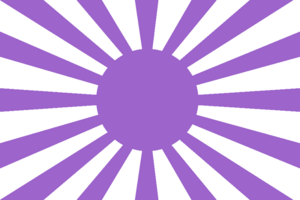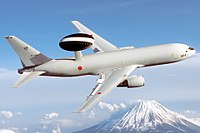Fuso Air Force
This article is incomplete because it is pending further input from participants, or it is a work-in-progress by one author. Please comment on this article's talk page to share your input, comments and questions. Note: To contribute to this article, you may need to seek help from the author(s) of this page. |
| Fuso Air Force 扶空軍 | |
|---|---|
| 扶空軍 | |
 | |
| Founded | July 12, 1950 |
| Country | Fusō |
| Type | Air force |
| Role | Aerial warfare |
| Size | 105,000 active personnel 65,400 reserve personnel 1,887 aircraft |
| Part of | Fuso Armed Forces |
| Garrison/HQ | Itogaya, Shojyuku, Edo |
| Motto(s) | "Fly first, finish first" |
| March | Gunkai Hokori |
| Commanders | |
| Commander-in-Chief | Sokuji Kado |
| Minister of Defense | Shirayuchi Mayumi |
| Chief of Staff, Joint Staff | Admiral Ino Matoko |
| Chief of the Air Staff | General Yukari Takamura |
The Fuso Air Force (扶空軍 Fuso Kugun) (FAF), is the air warfare branch of the Fuso Armed Forces, responsible for the defense of Fuso's airspace and for other aerospace operations. Regular combat air patrols are carried out throughout and beyond Fuso's territories and it's EEZ zones, and operations beyond the nation are carried out with objectives of establishing air superiority, rapid global mobility, global strike and command and control. The air force regularly participates in peacekeeping operations, specifically with the use of transport aircraft for the international community.
History
Historically much of Fuso's aviation during the Intercontinental War relied heavily on the aviation detachment of the Imperial Army. Following the dissolution of the Imperial military, and with the formation of the Fuso Armed Forces, with the Fuso Air Force as the aviation branch of the nation's military. Over the past 50 years, the air force saw a significant growth of it's size, command and structure due to an increase of the military budget, and the focus of the nation's military is the defense of the archipelago and it's interests reoriented the original plans of an air force solely on national defense. By the 21st century, the Fuso Air Force has over more than the amount of fighter craft required to make domestic and foreign operations possible.
Organization
Major units of the Fuso Air Force are the Air Operations Command, Air Defense Command, Air Support Command, Air Training Command, Air Development and Test Command, and Air Materiel Command. The Air Support Command is responsible for direct support of operational forces in rescue, transportation, control, weather monitoring and inspection. The Air Training Command is responsible for basic flying and technical training. The Air Development and Test Command, in addition to overseeing equipment research and development, is also responsible for research and development in such areas as flight medicine and etc.
The Air Operations Command is the premiere unit of the Air Force, solely focused on operations beyond Fuso. While the Air Defense Command unit focuses on the defense of Fuso and it's territories, with northern, central, southeast and western regional headquarters located at Aisawa, Ikuma, Korone and Saguta. The regional headquters for the southwest is located at Okina. All five regional headquarters control surface-to-air missile units of both the Fuso Army and Fuso Air Force located in their respective areas.
Equipment
The Fuso Air Force maintains an integrated network of radar installations and air defense direction centers throughout the country known as the Air Defense Ground Environment Control. The ADGEC saw significant improvements over the commissioning of E-2 Hawkeyes and the E-767 airborne early warning aircraft. Military satellites operated by the Fuso Air Force extends the capabilities of the ADGEC, as well as operations abroad. Interception of hostile aircraft relies on fighter-interceptor aircraft and surface-to-air missiles. Followed by a series of deployments of Patriot PAC systems on several areas of the Fusonese archipelago and it's islands. The Fuso Air Force also provides air support for ground and sea operations of the Fuso Army and the Fuso Navy and air defense for all bases and assets of all the forces.
Aircraft
Current inventory
| Aircraft | Type | Variant | In service | Notes | ||
|---|---|---|---|---|---|---|
| Combat Aircraft | ||||||
| Hitsubishi FA-2 | multirole | 153 | 120 FA-2s are assigned for ASM warfare with the Fuso Navy | |||
| Hitsubishi FA-15 | air superiority | FA-15C FA-15D |
58 388 |
68 FA-15Ds in production, 150 FA-15Cs in storage | ||
| FA-18 | multirole | FA-18B FA-18C |
182 143 |
|||
| FA-27 Seishin | stealth air superiority fighter | FA-27A | 56 | 30 ongoing trials, 15 in production, 12 more in order | ||
| Bombers | ||||||
| BA-97 Hiryu | Bomber | BA-97A BA-97B |
7 39 |
BA-97As slowly being replaced by the improved BA-97B bombers | ||
| AWACS | ||||||
| E-767 | early warning and control | 18 | ||||
| E-2 Hawkeye | early warning and control | E-2C E-2D |
8 24 |
|||
| Electronic Warfare | ||||||
| FA-18 | electronic warfare | EFA-18 | 38 | 10 more EFAs are planned for production and deployment. | ||
| Kagasaki C-1 | electronic warfare | CA-1 | 10 | |||
| Tanker | ||||||
| Takasaki P-1 | aerial refueling / transport | KP-1 | 28 | |||
| KC-130 | aerial refueling | KC-130T | 8 | will be replaced by the KP-1 by 2028. | ||
| Transport | ||||||
| B747 | VIP | 747-500 | 3 | call sign Fusonese Air Force One | ||
| Oceanastream V | VIP | 9 | ||||
| Kagasaki C-2 | transport / heavy transport | C-2A | 71 | more C-2s are being produced, the next delivery will come by November 2020. | ||
| A400M Atlas | transport | A400MF | 15 | Replacing the C-130 for general purpose transport | ||
| C-130 | transport | C-130J | 10 | Phased out and currently being decommissioned, 40+ in storage | ||
| Helicopters | ||||||
| CH-47 Chinook | transport / utility | CH-47J | 70 | |||
| Hitsubishi UH-60 | transport/ utility | 92 | ||||
| Trainer Aircraft | ||||||
| Hitsubishi FA-15 | conversion trainer | FA-15CJ | 110 | Replaced the FA-4D trainer jets | ||
| Kagasaki T-4 | jet trainer | 225 | Second batch is manufactured by Omitomo with sensor and flight improvements | |||
| aircraft name | aircraft role | 0 | ||||






